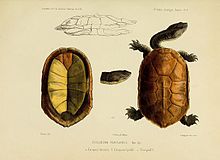Hydromedusa maximiliani
| Brazilian snake-necked turtle | |
|---|---|
 |
|
| Scientific classification | |
| Kingdom: | Animalia |
| Phylum: | Chordata |
| Subphylum: | Vertebrata |
| Class: | Sauropsida |
| Order: | Testudines |
| Suborder: | Pleurodira |
| Family: | Chelidae |
| Subfamily: | Hydromedusinae |
| Genus: | Hydromedusa |
| Species: | H. maximiliani |
| Binomial name | |
|
Hydromedusa maximiliani (Mikan, 1825) |
|
| Synonyms | |
|
|
The Brazilian snake-necked turtle (Hydromedusa maximiliani ), locally known as cágado da serra, is a species of chelid turtle endemic to southeastern Brazil. It is one of the smallest Brazilian freshwater turtles reaching a maximum carapace length of 20 cm (7.9 in). The species prefers streams with sandy and rocky bottoms and clear water in forests above 600 m (2,000 ft) elevation.
The specific name, maximiliani, is in honor of German naturalist Prince Maximilian of Wied-Neuwied.
First described as Emys maximiliani by Mikan (1825) it was subsequently moved to the genus Hydromedusa by Wagler (1830). Several other species described later have since been synonymized with this species. There are no recognised subspecies.
The Brazilian snake-necked turtle is a small species reaching a carapace length of between 10–20 cm (3.9–7.9 in) with a weight of 120–520 g (4.2–18.3 oz). The carapace of the adult is oval in shape varying in color from dark gray, through to dark or light brown. The plastron is a yellow or cream color. The species has a moderate sized head with a small snout and yellowish jaws, with no barbels on the chin, the iris is black. The dorsal surface of the head, neck and limbs are olive green to gray in color with a lighter cream colored ventral surface.
The Brazilian snake-necked turtle is endemic to southeastern Brazil, in the states of Bahia, Minas Gerais, Espírito Santo, Rio de Janeiro and São Paulo. The distribution is associated with the mountainous Atlantic rainforest. As a generalization it is found in mountain streams above 600 m (2,000 ft).
...
Wikipedia

